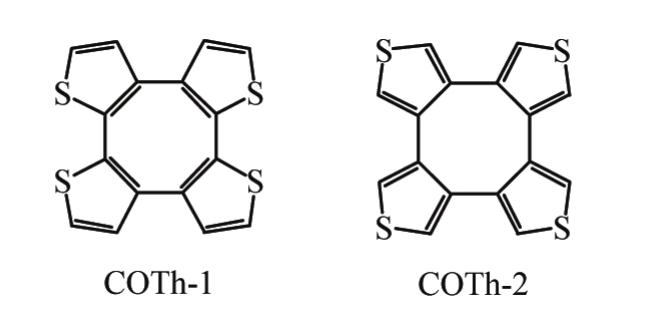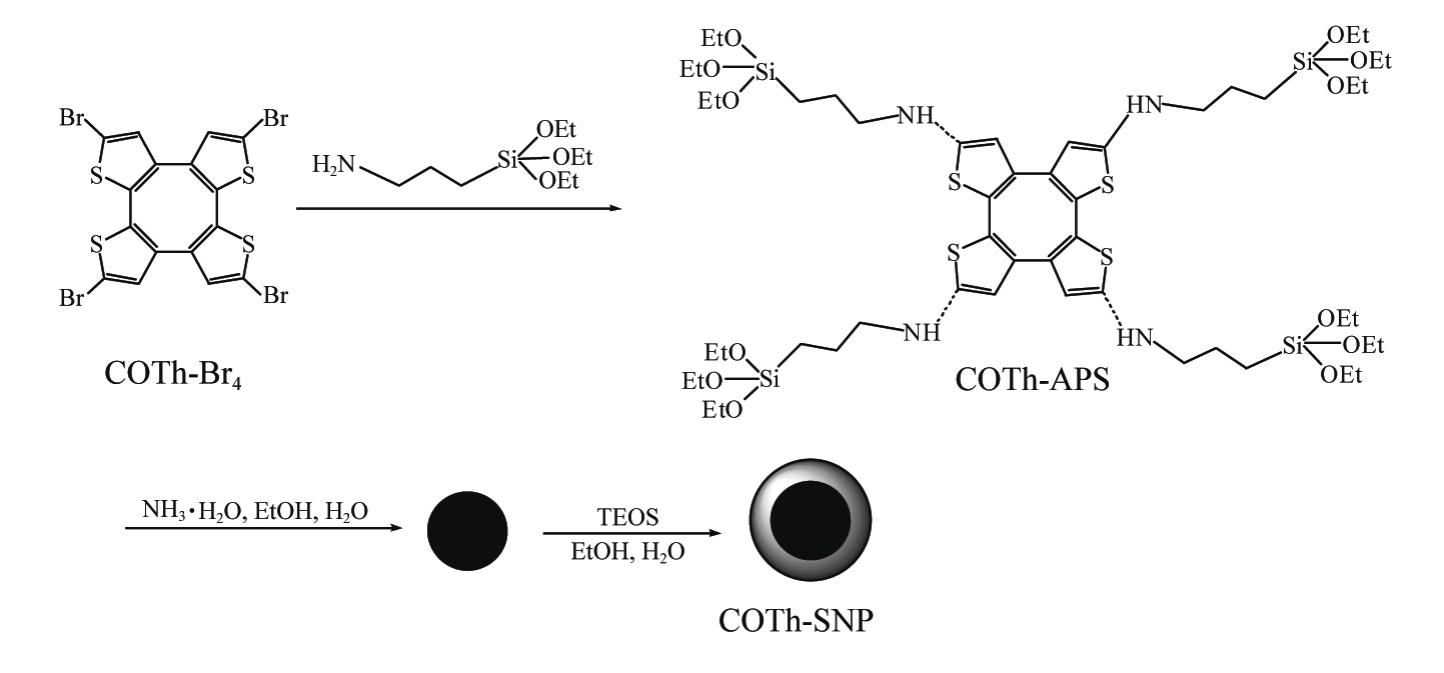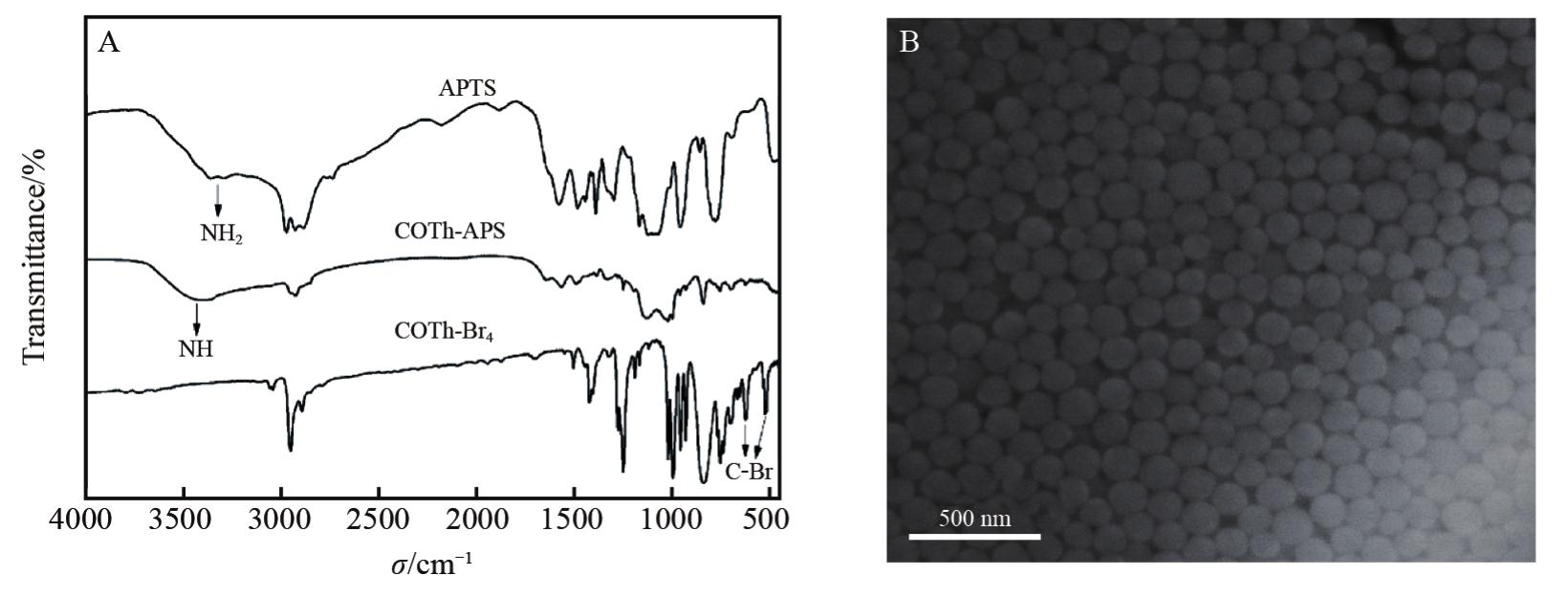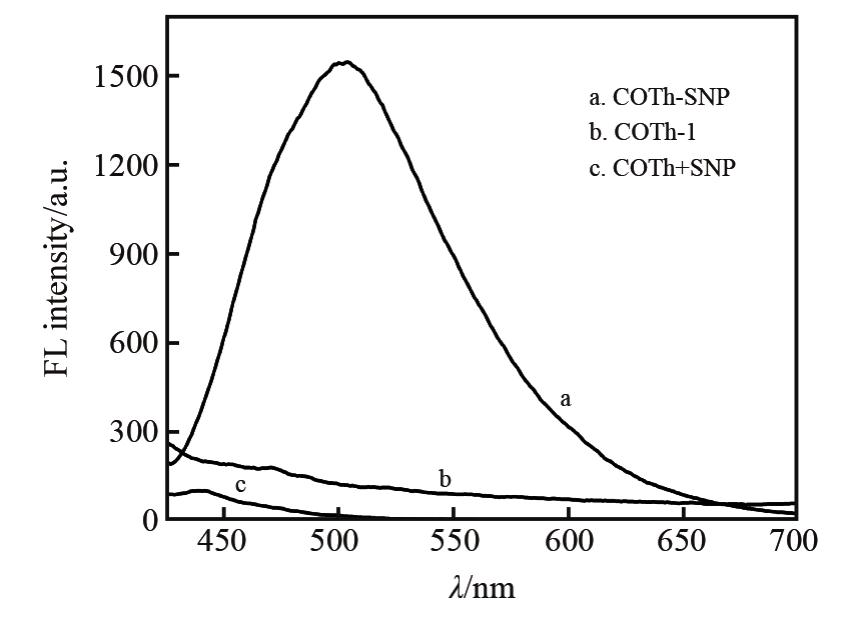
Chinese Journal of Applied Chemistry ›› 2022, Vol. 39 ›› Issue (02): 283-288.DOI: 10.19894/j.issn.1000-0518.210101
• Full Papers • Previous Articles Next Articles
Preparation of Saddle-Shaped Cyclooctatetrathiophene-Based Hybrid Nanomaterials and Fluorescence Properties
Chun-Mei ZHAO( ), Xiu-Miao ZHOU, Xi-Xi JIN, Yu-Hang WANG, Yi-Jing DANG
), Xiu-Miao ZHOU, Xi-Xi JIN, Yu-Hang WANG, Yi-Jing DANG
- School of Chemical Engineering& Food Science, Zhengzhou University of Thechnology, Zhengzhou 450044, China
-
Received:2021-03-08Accepted:2021-06-25Published:2022-02-10Online:2022-02-09 -
Contact:Chun-Mei ZHAO -
Supported by:Key Scientific Research Projects of Henan Province Colleges and Universities(20A150042);Undergraduate Inovation and Entrepreneurship Training Program of Zhengzhou University of Technology(201911068021);Key Laboratory of Low-Carbon Chemistry& Energy Conservation of Guangdong Province(20180101)
CLC Number:
Cite this article
Chun-Mei ZHAO, Xiu-Miao ZHOU, Xi-Xi JIN, Yu-Hang WANG, Yi-Jing DANG. Preparation of Saddle-Shaped Cyclooctatetrathiophene-Based Hybrid Nanomaterials and Fluorescence Properties[J]. Chinese Journal of Applied Chemistry, 2022, 39(02): 283-288.
share this article
Add to citation manager EndNote|Ris|BibTeX
URL: http://yyhx.ciac.jl.cn/EN/10.19894/j.issn.1000-0518.210101
| [1] | MARSELLA M J, REID R J. Toward molecular muscles: design and synthesis of an electrically conducting poly [cyclooctatetrathiophene] [J]. Macromolecules, 1999, 32(18):5982-5984. |
| [2] | DADVAND A, CICOIRA F, KONSTANTIN Y C, et al. Heterocirculenes as a new class of organic semiconductors[J]. Chem Commun, 2008(42):5354-5356. |
| [3] | FUJIMOTO T, MATSUSHITA M M, YOSHIKAWA H Y, et al. Electrochemical and electrochromic properties of octathio[8]circulene thin films in ionic liquids[J]. J Am Chem Soc, 2008, 130(47):15790-15791. |
| [4] | ZHAO C M, XU L, WANG Y, et al. Recent progress in the synthesis and application of saddle-shaped cyclooctatetrathiophenes and their derivatives[J]. Chinese J Chem, 2015, 33(1):71-78. |
| [5] | LI L, ZHAO C M, WANG H. Recent progress in synthesis and application of thiophene oligomers based on bithiophene dicarbanions[J]. Chem Rec, 2016, 16(2):797-809. |
| [6] | GREVIIIG B, WOLTERMANN A, KAUFMANN T. Preparation and properties of cycloocta[1, 2-b:4, 3-b′:5, 6-b″:8, 7-b′″]tetrathiophene[J]. Angew Chem Int Ed, 1974, 13(7):467-468. |
| [7] | WANG Y, SONG J S, XU L, et al. Synthesis and characterization of cyclooctatetrathiophenes with different connection sequences[J]. J Org Chem, 2014, 79(5):2255-2262. |
| [8] | KAUFFMANN T, MACKOWIAK H P. 2-Lithio-(all-αS) cyclotetrathiophen: synthese und präparative anwendungen[J]. Chem Ber, 1985, 118(6):2343-2352. |
| [9] | WANG Y, GAO D W, SHI J W, et al. Derivation of saddle shaped cyclooctatetrathiophene: increasing conjugation and fabricating pentamer[J]. Tetrahedron, 2014, 70(3):631-636. |
| [10] | ZHAO C M, CAI X, MA Z Y, et al. Excimer from particially overlapped anthracene dimer based on saddle-shaped cyclooctatetrathiophene as spacer[J]. J Photoch Photobio A, 2018, 355318-325. |
| [11] | MARSELLA M J, KIM I T, THAM F. Toward conjugated double helical ladder polymers: cyclooctatetrathiophene as a highly versatile double helical scaffold[J]. J Am Chem Soc, 2000, 122(5):974-975. |
| [12] | LI C L, SHI J W, XU L, et al. Syntheses and crystal structures of fused thiophenes:[7]helicene and double helicene, a D2-symmetric dimer of 3, 3′-bis (dithieno[2, 3-b:3′, 2′-d]thiophene)[J]. J Org Chem, 2009, 74(1):408-411. |
| [13] | ZHANG S, LIU X M, LI C L, et al. Thiophene-based double helices: syntheses, X-ray structures, and chiroptical properties[J]. J Am Chem Soc, 2016, 138(31):10002-10010. |
| [14] | ZHAO C M, MA Z Y, LI C L, et al. Thiophene and naphthalene-based double helix: synthesis, structures and chirality[J]. Chinese Chem Lett, 2021, 32(1):457-460. |
| [15] | CHERNICHENKO K Y, SUMERIN V V, SHPANCHENKO R V, et al. “Sulflower”: a new form of carbon sulfide[J]. Angew Chem Int Ed, 2006, 45(44):7367-7370. |
| [16] | LI L, LI B B, LI C L, et al. Selective deprotonation of tetra[3, 4]thienylene in the presence of n-BuLi[J]. Org Chem Front, 2017, 4(6):1019-1023. |
| [17] | OHMAE T, NISHINAGA T, WU M, et al. Cyclic tetrathiophenes planarized by silicon and sulfur bridges bearing antiaromatic cyclooctatetraene core: syntheses, structures, and properties[J]. J Am Chem Soc, 2010, 132(3):1066-1074. |
| [18] | SUN C J, WANG P F, WANG H, et al. All-thiophene-based conjugated porous organic polymers[J]. Polym Chem, 2016, 7(31):5031-5038. |
| [19] | MARSELLA M J, REID R J, ESTASSI S, et al. Tetra[2, 3-thienylene]: a building block for single-molecule electromechanical actuators[J]. J Am Chem Soc, 2002, 124(42):12507-12510. |
| [20] | MARSELLA M J. Classic annulenes, nonclassical applications[J]. Acc Chem Res, 2002, 35(11):944-951. |
| [21] | LUO J D, XIE Z L, LAM J W Y, et al. Aggregation-induced emission of 1-methyl-1, 2, 3, 4, 5-pentaphenylsilole[J]. Chem Commun, 2001(18):1740-1741. |
| [22] | TANG B Z, ZHAN X W, YU G, et al. Efficient blue emission from siloles[J]. J Mater Chem, 2001, 11(12):2974-2978. |
| [23] | MEI J, LEUNG N L C, KWOK R T K, et al. Aggregation-induced emission: together we shine, united we soar[J]. Chem Rev, 2015, 115(21):11718-11940. |
| [24] | HE Z K, KE C Q, TANG B Z. Journey of aggregation-induced emission research[J]. ACS Omega, 2018, 3(3):3267-3277. |
| [25] | ZHAO Z, ZHENG X Y, DU L L, et al. Non-aromatic annulene-based aggregation-induced emission system via aromaticity reversal process[J]. Nat Commun, 2019(10):2952. |
| [26] | 张卫杰, 徐莉, 宋金生, 等. “马鞍型”环八四噻吩-三嗪体系的合成与聚集诱导发光(AIE)性质研究[J]. 有机化学, 2018, 38(5):1119-1125. |
| ZHANG W J, XU L, SONG J S, et al. Synthesis of saddle-shaped cyclooctatetrathiophene-triazine derivatives and their aggregation induced emissions (AIE) properties[J]. Chinese J Org Chem, 2018, 38(5):1119-1125. | |
| [27] | LIU M Y, GAO P, WAN Q, et al. Recent advances and future prospects of aggregation-induced emission carbohydrate polymers[J]. Macromol Rapid Commun, 2017, 38(10):1600575. |
| [28] | PICARD-LAFON A, DAIGLE M, MORIN J F. Tetraphenylethene-diyne hybrid nanoparticles from glaser-type dispersion polymerization[J]. RSC Adv, 2017, 7(57):36132-36137. |
| [29] | FAISAL M, HONG Y N, LIU J Z, et al. Fabrication of fluorescent silica nanoparticles hybridized with AIE luminogens and exploration of their applications as nanobiosensors in intracellular imaging[J]. Chem Eur J, 2010, 16(14):4266-4272. |
| [30] | PEREGO C, MILLINI R. Porous materials in catalysis: challenges for mesoporous materials[J]. Chem Soc Rev, 2013, 42(9):3956-3976. |
| [31] | MAY A, PASC A, STÉBÉM J, et al. Tailored jeffamine molecular tools for ordering mesoporous silica[J]. Langmuir, 2012, 28(25):9816-9824. |
| [32] | SON W J, CHOI J S, AHN W S. Adsorptive removal of carbon dioxide using polyethyleneimine-loaded mesoporous silica materials[J]. Micropor Mesopor Mat, 2008, 113(1/2/3):31-40. |
| [33] | SLOWING I I, TREWYN B G, GIRI S, et al. Mesoporous silica nanoparticles for drug delivery and biosensing applications[J]. Adv Funct Mater, 2007, 17(8):1225-1236. |
| [34] | ZHOU Y X, QUAN G L, WU Q L, et al. Mesoporous silica nanoparticles for drug and gene delivery[J]. Acta Pharm Sin B, 2018, 8(2):165-177. |
| [35] | MATSUURA A, KOMASTU K. Efficient synthesis of benzene and planar cyclooctatetraene fully annelated withbicycle[2.1.1]hex-2-ene[J]. J Am Chem Soc, 2001, 123(8):1768-1769. |
| [36] | WANG Y G, WANG Z H, ZHAO D F, et al. Efficient synthesis of trimethyl-substituted dithieno[2, 3-b:3′, 2′-d]thiophene, tetra[2, 3-thienylene]and hexa[2, 3-thienylene]from substituted[3, 3′]bithiophenyl[J]. Synlett, 2007(5):2390-2394. |
| [37] | YANG Y J, GU Y R, MA Z Y, et al. Aggregation-induced emission and pressure-dependent fluorescent of aryl cyclooctatetrathiophenes[J]. Dyes Pigm, 2021, 184:108803. |
| [1] | Nan-Yu LIN, Feng GAO, Jiang-Ying QU, Jing-Jing TU, Wei-Jun ZHONG, Yun-Hao ZANG. Preparation of Super-hydrophilic/Underwater Oil-phobic High Silicon Cloth and Its Oil-water Separation Performance [J]. Chinese Journal of Applied Chemistry, 2023, 40(3): 449-459. |
| [2] | Qin ZHANG, Wen-Bin LIU, Li-Jiao FAN, Yu-Ming XIE, Guo-Lin HUANG. Research Progress in the Preparation of Functionalized Mesoporous Silica and Its Application in Adsorption and Separation of Uranium from Water [J]. Chinese Journal of Applied Chemistry, 2023, 40(2): 169-187. |
| [3] | Feng LI, Shi-Yu LU, Yu ZHANG, Li-Jun GUO, Xue ZHAI, Cui-Qin LI. Catalytic Properties of Silylated⁃Salicylaldimine Transition Metal Complexes Functionalized Nano⁃silica Catalysts in Ethylene Oligomerization [J]. Chinese Journal of Applied Chemistry, 2022, 39(6): 949-959. |
| [4] | Jian-Shu XIAO, Yu-Ge WANG, Qian-Qian GU, Zhi-Cai ZHANG, Yong-Peng LYU, Yuan YIN, Hong-Guo SUN, Ya-Fang ZHENG, Zhao-Yan SUN. Formation of Network by Carbon Black, Silica and Their Mixing Fillers in Isoprene Rubber [J]. Chinese Journal of Applied Chemistry, 2022, 39(12): 1833-1841. |
| [5] | Yu-Le WANG, Ke-Li YANG, Yan-Fang GAO. Preparation and Electrochemical Properties of Molybdenum Carbide Modified Silica [J]. Chinese Journal of Applied Chemistry, 2022, 39(11): 1716-1725. |
| [6] | GUO Wei, WANG Yaming, JIANG Lihong, ZHENG Yan'e, LIU Biying. Preparation of Sulfonated Chiral Nematic Mesoporous Silicate Solid Acid and Its Catalytic Synthesis of Borneol [J]. Chinese Journal of Applied Chemistry, 2020, 37(12): 1447-1456. |
| [7] | CAI Min, WU Chunyan, XIE Yishun, BAN Gui, LAI Feiyan, HUANG Xiaoying, ZHANG Xiaohui. Effects of Ethyl Orthosilicate on the Electrochemical Performance of High-Voltage Lithium Nickel Manganese Oxide-Based Full-Cell [J]. Chinese Journal of Applied Chemistry, 2020, 37(11): 1301-1308. |
| [8] | DONG Xun, ZHU Xiaping, CUI Ting. Preparation and Properties of Mercapto Bentonite [J]. Chinese Journal of Applied Chemistry, 2020, 37(10): 1156-1163. |
| [9] | HOU Chengmin,LI Na,DONG Haitao,KOU Yanping. Preparation and Performance of Hybrid Superhydrophobic Materials from Fluorinated Epoxy Resin and Silica Nanoparticles [J]. Chinese Journal of Applied Chemistry, 2019, 36(7): 798-806. |
| [10] | CHEN Guangmei,WANG Zhikun,WU Lixia,HUANG Yiping. Preparation and Properties of Polyurethane Modified by Acrylate/Nano-SiO2 Composites [J]. Chinese Journal of Applied Chemistry, 2019, 36(5): 532-538. |
| [11] | Yuefeng DENG, Yanhua SONG, Ji CHEN, Chuanying LIU, Deqian LI, Yu LIU, Hailian LI. Influence of Impurity in Lu2O3 on Spectral Properties of Lu2SiO5∶Ce Polycrystalline Powders [J]. Chinese Journal of Applied Chemistry, 2018, 35(4): 457-461. |
| [12] | WANG Dongsheng,WEN Xin,LI Yunhui,TANG Tao. Silica Grafted 9,10-Dihydro-9-oxa-10-phosphaphenanthrene-10-oxide and Its Effect on Flame Retardancy and Transparency of Polymethyl Methacrylate Nanocomposites [J]. Chinese Journal of Applied Chemistry, 2018, 35(12): 1427-1433. |
| [13] | LIU Di,TONG Huan,YUAN Linjie,ZHANG Zipeng,MA Kangfu,YUAN Lin,ZHANG Wanyu,CHEN Lidong,WANG Xiangsheng,GUO Hongchen. Preparation of High Activity Oxidative Desulfurization Catalyst from Phosphomolybdic Acid and Titania Silica Nanocomposite [J]. Chinese Journal of Applied Chemistry, 2018, 35(11): 1351-1356. |
| [14] | MENG Qingnan,DU Lulu,TANG Yufei,ZHAO Kang,ZHAO Lang. Preparation and Catalytic Properties of MnOX-C@SiO2 Core-Shell Particles [J]. Chinese Journal of Applied Chemistry, 2018, 35(11): 1357-1363. |
| [15] | TAN Yuhui,LIU Yi,CHEN Shaopeng,WANG Changfeng,TANG Yunzhi. Syntheses, Structure and Photo-Luminescent Properties of MnⅡ Complex with 2-(1H-1,2,4-Triazol-3-yl)pyridine [J]. Chinese Journal of Applied Chemistry, 2018, 35(10): 1249-1255. |
| Viewed | ||||||
|
Full text |
|
|||||
|
Abstract |
|
|||||



